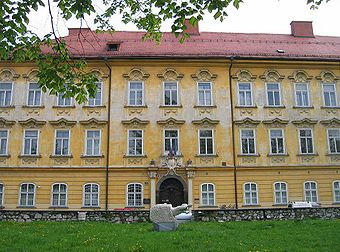
Gruber Palace
Encyclopedia

Ljubljana
Ljubljana is the capital of Slovenia and its largest city. It is the centre of the City Municipality of Ljubljana. It is located in the centre of the country in the Ljubljana Basin, and is a mid-sized city of some 270,000 inhabitants...
, the capital of Slovenia
Slovenia
Slovenia , officially the Republic of Slovenia , is a country in Central and Southeastern Europe touching the Alps and bordering the Mediterranean. Slovenia borders Italy to the west, Croatia to the south and east, Hungary to the northeast, and Austria to the north, and also has a small portion of...
located on the Ljubljanica
Ljubljanica
The Ljubljanica is a river in the southern part of Ljubljana Basin in Slovenia. The capital of Slovenia, Ljubljana, is situated on the river. The Ljubljanica rises to the south of the town Vrhnika and outflows in the Sava River about downstream from Ljubljana. Its largest affluent is Mali graben....
river bank. It currently houses the Archives of the Republic of Slovenia.
History
The palace was built between 1773 and 1781 in a braided BaroqueBaroque
The Baroque is a period and the style that used exaggerated motion and clear, easily interpreted detail to produce drama, tension, exuberance, and grandeur in sculpture, painting, literature, dance, and music...
and Rococo
Rococo
Rococo , also referred to as "Late Baroque", is an 18th-century style which developed as Baroque artists gave up their symmetry and became increasingly ornate, florid, and playful...
style by the Jesuit Viennese
Vienna
Vienna is the capital and largest city of the Republic of Austria and one of the nine states of Austria. Vienna is Austria's primary city, with a population of about 1.723 million , and is by far the largest city in Austria, as well as its cultural, economic, and political centre...
hydrology expert and architect Gabriel Gruber
Gabriel Gruber
Gabriel Gruber was the second Superior General of the Society of Jesus in Russia.-Early years and education:...
who as the builder of the Gruberjev kanal drainage channel used the palace as a physics and hydraulics research institute. Testament to this is that he equipped the palace with its own astronomical observatory
Observatory
An observatory is a location used for observing terrestrial or celestial events. Astronomy, climatology/meteorology, geology, oceanography and volcanology are examples of disciplines for which observatories have been constructed...
for the purposes of Gruber's School of Hydraulics and Mechanics. Gruber was later deported to Russia
Russia
Russia or , officially known as both Russia and the Russian Federation , is a country in northern Eurasia. It is a federal semi-presidential republic, comprising 83 federal subjects...
around 1784.
In 1840, the palace was purchased by Anton Virant who merged the property with his own adjacent and used it as a guest accommodation and cafe named "Zur Sternwarte" (meaning observatory). In 1887, it was bought by the Carniolan Saving Bank and in 1965, become the National Archive of Slovenia, undergoing renewal in 1990.
Architecture
The palace is designed in the late BaroqueBaroque
The Baroque is a period and the style that used exaggerated motion and clear, easily interpreted detail to produce drama, tension, exuberance, and grandeur in sculpture, painting, literature, dance, and music...
and Rococo
Rococo
Rococo , also referred to as "Late Baroque", is an 18th-century style which developed as Baroque artists gave up their symmetry and became increasingly ornate, florid, and playful...
style by highly shilled stucco
Stucco
Stucco or render is a material made of an aggregate, a binder, and water. Stucco is applied wet and hardens to a very dense solid. It is used as decorative coating for walls and ceilings and as a sculptural and artistic material in architecture...
artisans who commissioned to decorate its façade and interior. The Palace is noted for its oval staircase in cool pastel colors of the era and braided and is topped with a domed ceiling designed allegorically, it is a fresco
Fresco
Fresco is any of several related mural painting types, executed on plaster on walls or ceilings. The word fresco comes from the Greek word affresca which derives from the Latin word for "fresh". Frescoes first developed in the ancient world and continued to be popular through the Renaissance...
of trade
Trade
Trade is the transfer of ownership of goods and services from one person or entity to another. Trade is sometimes loosely called commerce or financial transaction or barter. A network that allows trade is called a market. The original form of trade was barter, the direct exchange of goods and...
, crafts and technology
Technology
Technology is the making, usage, and knowledge of tools, machines, techniques, crafts, systems or methods of organization in order to solve a problem or perform a specific function. It can also refer to the collection of such tools, machinery, and procedures. The word technology comes ;...
, completed in 1786 by Andrej Herrlein, two years after Gruber himself had been forced to leave.
On the first floor of the palace is a chapel adorned with paintings depicting the life of the Virgin Mary which were painted by the Austrian painter Martin Johann Schmidt
Martin Johann Schmidt
Martin Johann Schmidt, called Kremser Schmidt or Kremserschmidt, , was one of the most outstanding Austrian painters of the late Baroque/Rococo along with Franz Anton Maulbertsch.A son of the sculptor Johannes Schmidt and a pupil of Gottlieb Starmayr, he spent...
, also known as Kremser Schmidt.
External links
- http://www.lonelyplanet.com/worldguide/slovenia/ljubljana/sights/1000297730City location Lonely PlanetLonely PlanetLonely Planet is the largest travel guide book and digital media publisher in the world. The company is owned by BBC Worldwide, which bought a 75% share from the founders Maureen and Tony Wheeler in 2007 and the final 25% in February 2011...
]

